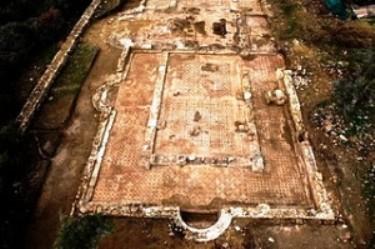Cyprus Department of Antiquities Reveals Proto-Byzantine Monument at Akrotiri Peninsula
Stella Tsolakidou
Source - http://eu.greekreporter.com/2011/10/27/cyprus-department-of-antiquities-reveals-proto-byzantine-monument-at-akrotiri-peninsula/
The Department of Antiquities in Cyprus has revealed a monument of the proto-byzantine period after year long excavations at the site of Katalymmata ton Plakoton at the Akrotiri peninsula under the directions of the Senior Archaeological officer of the Department, Dr Eleni Procopiou.
The excavations begun in 2007, uncovering a peculiar narthex-martyrion forming a T-shape plan with 3 aisled branches and are expected to continue for the following years until the total area is brought to light.

The date of the erection has been determined at the end of the first decade of the reign of emperor Heraclius (616-619 A.D.), whereas its abandonement and destruction happened slightly before the middle of the 7th century.
The date of the erection of the monument between 616-619 A.D (at the end of the first decade of the reign of emperor Heraclius), the short period of its life (abandonment and destruction slightly before the middle of the 7th century), its typological similarity with the Justinian martyrion of Abu Mina in Mayrut of Alexandria and its elaborate liturgical order, as well as its funerary character suggests its identification with one of the places erected especially for giving refugee to the in-juncture Churches/Patriarchates of the Eastern Provinces of the Empire (Syria, Palestine, Egypt), who passed during this period under the Persians.
The uniqueness of the monument and the ornamental mosaics of its floors and other parts are suggesting that this must have been a grandiose monument of its time, which had been designed for ecclesiastic purposes and honoring sacred shrines. The best preserved inscription is that of the north aisle which bears the first verse of the 142nd psalm of David “My lord listen to my prayer”.
The findings included many bronze coins instrumental for the dating of the monument and bronze brackets used for securing the revetments, iron nails, fragmentary marble offering tables, glass fragments from windows and glass oil lamps.
The project was additionally assisted by Mrs. Mary Chamberlain, technician of the Department of Antiquities in Nicosia, the conservation team of the Department of Antiquities in Limassol and many Cypriot volunteers, while it also provided archaeological expertise to postgraduate students from UK universities and through the Graduate European Archaeological Skills Exchange (GrEASE), Leonardo da Vinci programme.